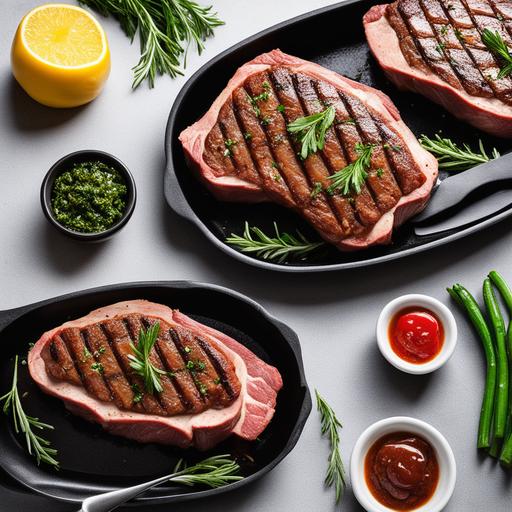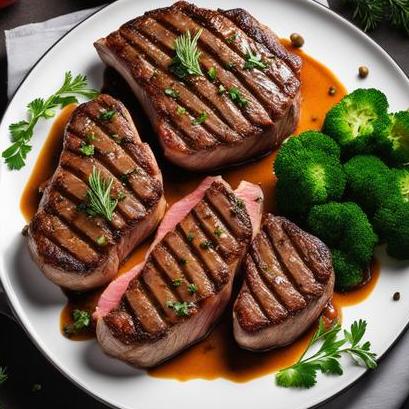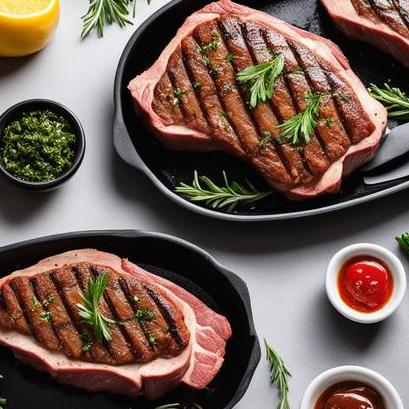
Juicy Steaks Oven Recipe: A Comprehensive Guide
Welcome to the world of mouth-watering, juicy steaks cooked to perfection in the oven! Whether you’re a novice chef or an experienced cook, this comprehensive guide will help you achieve steak excellence every time. From understanding the science behind cooking to selecting the right cut, cleaning, and preparation, we will cover every aspect to ensure your steaks turn out absolutely heavenly. So, let’s dive into the tantalizing world of steak science and culinary artistry!
Food Science – Unlocking the Secrets
Before we embark on this culinary journey, let’s understand the science behind juicy steaks. The key to achieving succulent results lies in the composition of the meat and the reactions that occur during cooking.
1. Meat Composition
Knowing the composition of meat can help us understand how it reacts to different cooking methods. A steak primarily consists of muscle fibers, connective tissues, and fat. The muscle fibers are responsible for the chewiness, while the connective tissues determine the tenderness. The fat, on the other hand, contributes to the juiciness and flavor.
2. Maillard Reaction
The Maillard reaction is a crucial process that takes place during cooking, responsible for creating the desirable flavors and aromas we associate with a perfectly cooked steak. This reaction occurs between amino acids and reducing sugars, resulting in a beautiful golden-brown crust on the surface of the meat.
Choosing the Right Cut
Selecting the right cut of meat is essential to achieving a juicy steak. Here are a few popular options:
1. Ribeye
Known for its rich marbling and intense flavor, ribeye is a popular choice among steak lovers. The marbling of fat throughout the meat helps ensure a tender and juicy steak.
2. New York Strip
New York Strip, or simply strip steak, is another top-notch choice. It offers a balance of tenderness and flavor with a moderate amount of fat marbling.
3. Filet Mignon
If tenderness is your top priority, look no further than the tenderloin or filet mignon. Although it may not have as much fat marbling as other cuts, its buttery-smooth texture is unparalleled.
Cleaning and Preparation

Proper cleaning and preparation are vital steps in creating a delectable steak. Follow these tips to get your steaks ready for cooking:
1. Thawing
If using frozen steaks, ensure they are fully thawed before cooking. This can be done by placing them in the refrigerator overnight or using the defrost function on your microwave.
2. Seasoning
Apply a generous amount of kosher salt and freshly ground black pepper to both sides of the steak, gently pressing the seasoning into the meat. Allow the steak to rest at room temperature for about 30 minutes before cooking.
Tips and Variations

Optimize your steak-cooking game with these useful tips and explore exciting flavor variations:
1. Resting Time
After your steak is cooked, allow it to rest for at least five minutes before slicing. This gives the juices time to redistribute throughout the meat, resulting in a juicier and more flavorful steak.
2. Marinades and Rubs
Experiment with marinades and rubs to enhance the flavor profile of your steak. For marinades, combine various ingredients such as soy sauce, minced garlic, Worcestershire sauce, and fresh herbs. Rubs, on the other hand, can be as simple as a mixture of salt, pepper, and smoked paprika.
3. Different Cuts, Different Techniques
Each cut of meat may require slight variations in cooking techniques. While thicker cuts like ribeye benefit from searing and then finishing in the oven, leaner cuts like filet mignon are well-suited for a reverse sear, where they are first cooked in the oven and finished with a quick sear on the stovetop.
Doneness Checks – Achieving Steak Perfection

Knowing how to check the doneness of your steak is crucial to achieving the desired level of cooking. Here are some methods to determine if your steak is cooked to perfection:
1. Meat Thermometer
Investing in a meat thermometer is highly recommended to ensure accuracy. For medium-rare, aim for an internal temperature of around 135°F (57°C). Keep in mind that the temperature will rise a few degrees as the steak rests.
2. Finger Test
If you don’t have a thermometer on hand, the finger test can be a helpful alternative. Gently press the meat with your finger and compare the resistance to the different parts of your hand. A steak cooked to medium-rare should feel similar to the base of your thumb when your hand is relaxed.
The Recipe – Unleashing the Juicy Steak Magic

Now that you’re armed with all the necessary knowledge, let’s put it into practice! Here’s a simple yet foolproof recipe to achieve juicy steaks in the oven:
**Ingredients:**
- 2 steaks of your choice (e.g., ribeye, New York Strip, or filet mignon)
- Kosher salt
- Freshly ground black pepper
- Olive oil
**Instructions:**
1. Preheat your oven to 400°F (200°C).
2. Season both sides of the steaks liberally with kosher salt and freshly ground black pepper.
3. Heat an oven-safe skillet over high heat. Drizzle olive oil into the skillet and sear the steaks for 2-3 minutes on each side until a golden-brown crust forms.
4. Transfer the skillet with the seared steaks to the preheated oven and cook for an additional 4-6 minutes, or until your desired doneness is reached.
5. Remove the steaks from the oven and let them rest for about 5 minutes before slicing.
6. Serve your succulent, juicy steaks as is, or accompany them with your favorite side dishes for a complete, satisfying meal.
Enjoy your masterpiece!
Avoiding Overcooking and Undercooking – Your Steaks Deserve Perfection
Achieving the perfect level of doneness can be challenging, but with practice and attentiveness, you’ll master it in no time! Here are some tips to help you avoid overcooking or undercooking your steaks:
1. Use a Timer
Keeping track of your cooking time is crucial. Set a timer to ensure you don’t accidentally overcook your steak.
2. Practice Makes Perfect
Steak doneness can greatly vary depending on personal preferences. Experiment with cooking times to find the sweet spot for your taste buds.
3. Always Remember to Rest
As mentioned earlier, resting your steak is essential. It allows the juices to redistribute and ensures a flavorful and juicy result.
Conclusion
Cooking a juicy steak in the oven is undoubtedly an art form that requires passion, knowledge, and practice. By understanding the science, selecting the right cut, mastering cleaning and preparation techniques, and following our recipe and tips, you’ll soon be serving up steaks that are bursting with flavor and tenderness. Embrace the challenge and enjoy embarking on this gourmet journey each time you step into your kitchen. So, roll up your sleeves, sharpen your knives, and prepare to impress yourself and your loved ones with the steak prowess you’re about to acquire!
FAQS On Juicy Steaks Oven Recipe
What Cut Of Meat Is Best For Juicy Steaks In The Oven?
For juicy steaks in the oven, it’s best to use cuts with high marbling such as ribeye, New York strip, or sirloin.
How Should I Prepare The Steaks Before Putting Them In The Oven?
Before cooking, allow the steaks to come to room temperature for about 30 minutes. Season them generously with salt and pepper, and if desired, any additional spices or herbs.
What Temperature And Cooking Time Is Best For Juicy Steaks In The Oven?
Preheat your oven to 400°F (204°C) and cook the steaks for about 6-8 minutes for medium-rare, or 8-10 minutes for medium, depending on the thickness of the steak.
Should I Sear The Steaks Before Putting Them In The Oven?
Searing the steaks before baking is optional, but it can help to develop a flavorful crust. Simply heat a cast-iron skillet over high heat and sear each side of the steak for 2-3 minutes before transferring to the oven.
How Can I Tell When The Steaks Are Done Cooking In The Oven?
The best way to ensure your steaks are cooked to your desired level of doneness is to use an instant-read meat thermometer. For medium-rare, the internal temperature should reach 130-135°F (54-57°C), and for medium, it should be 135-145°F (57-63°C). Let the steaks rest for 5-10 minutes before slicing and serving.


